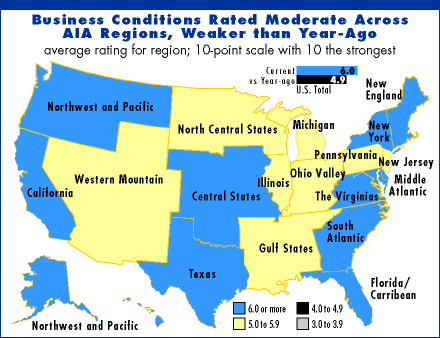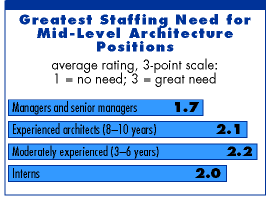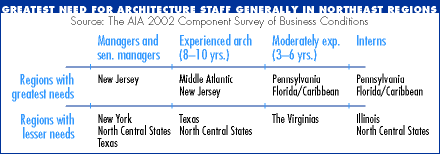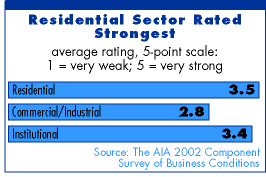
Coastal Regions
Annual survey finds need for staff easing, residential sector strong

AIA Chief Economist
This year's AIA 2002 Component Survey of Business Conditions shows the construction market struggling to show some improvement, with the need for architecture staff limited in most categories. A year ago, the survey of AIA components occurred around the events of September 11, and the implications of the terrorist attacks on the U.S. economy in general and the construction industry specifically were just developing.
In retrospect, the downturn in the economy accelerated following the September 11 events, but the economy showed signs of recovering entering 2002. However, moving through the year, the economic recovery has been uneven at best.
For architecture firms, the improvement in business conditions this year has been even more elusive. Component executives and presidents rate current conditions as 6.0 on average on a 10-point scale, right in the middle of the "so-so" category. The perceived variation in business conditions across regions was minimal. The lowest-rated regions were Illinois and Ohio Valley, with average ratings of 5.3. The highest-rated region was The Virginias at 6.8, well above the second-place regions of California and Central States at 6.4.
Respondents in virtually all regions felt that business conditions had deteriorated from last year. With a score of "1" indicating much worst and "10" indicating much better than a year ago, the average score nationally was 4.9. Only a few regions—New Jersey, New York, and Northwest and Pacific—felt that business conditions at firms in their regions had improved even modestly over the past year. In contrast, respondents in the Michigan, Ohio Valley, Central States, Illinois, New England, and Western Mountain regions felt that business conditions had substantially deteriorated from last year.

![]()
![]()
Sluggish construction
activity reduces staffing needs
In contrast to the late 1990s, when architecture staff at all experience
levels was in great demand, a sluggish construction sector has greatly
eased staffing shortages at firms in most regions of the country. On average,
nationally, there is some need for more-experienced architects, moderately
experienced architects, and interns and a more limited need for managers
and senior managers.
 However,
the need for architecture staff at various experience levels varies considerably
across regions. While all other regions indicate only some need to no
need for managers and senior managers, respondents from the New Jersey
region report a reasonably great need for architects at these levels.
However,
the need for architecture staff at various experience levels varies considerably
across regions. While all other regions indicate only some need to no
need for managers and senior managers, respondents from the New Jersey
region report a reasonably great need for architects at these levels.
For experienced architects, respondents in the Middle Atlantic and New Jersey regions report a great need, while those in the Florida/Caribbean and Pennsylvania regions report substantial need. Respondents in the Pennsylvania, Florida/Caribbean, and New York regions all report a great need for moderately experienced architects. Respondents didn't report a great need for interns in any regions, but reported a moderate need in the Pennsylvania, Florida/Caribbean, and New Jersey regions.

Residential construction
rated strongest sector
Low mortgage rates have helped keep the residential construction market
strong in spite of a slowdown in many other construction sectors. While
component executives and presidents rate the residential sector the strongest
nationally, that also is the case in most regions. Respondents in 14 of
the 18 AIA regions rate the residential market as stronger or as strong
when compared to the commercial/industrial and institutional sectors.
Respondents in the New Jersey and Middle Atlantic regions were particularly
upbeat in their assessment of the residential sector.
 Components
report that commercial and industrial construction still is not fully
recovered. Respondents in every region rated commercial/industrial activity
as the weakest (or tied for the weakest) major construction sector. The
institutional sector, while easing a bit in some regions, is still uniformly
healthy. Respondents in all AIA regions rated the health of this sector
as moderate, with those from the California region rating it as strong
on average.
Components
report that commercial and industrial construction still is not fully
recovered. Respondents in every region rated commercial/industrial activity
as the weakest (or tied for the weakest) major construction sector. The
institutional sector, while easing a bit in some regions, is still uniformly
healthy. Respondents in all AIA regions rated the health of this sector
as moderate, with those from the California region rating it as strong
on average.
Copyright 2001 The American Institute of Architects. All rights reserved.
![]()
| Survey Highlights: • Regional business conditions at architecture firms rated as just "so-so" on average by AIA component executives and presidents • Respondents in most regions rate conditions as slightly worse than a year ago • Mid-level architecture positions continue to be in greatest need; manager and senior manager positions rated as the lowest need • Residential and institutional construction sectors continue to be the healthiest; commercial/industrial rated weak to moderate. |
|